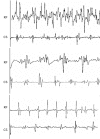Is Mapping of Complex Fractionated Electrograms Obsolete?
- PMID: 26835111
- PMCID: PMC4711559
- DOI: 10.15420/aer.2015.04.02.109
Is Mapping of Complex Fractionated Electrograms Obsolete?
Abstract
Atrial fibrillation is the most common clinically encountered arrhythmia and catheter ablation has emerged as a viable treatment option in drug-refractory cases. Pulmonary vein isolation is widely regarded as the cornerstone for successful outcomes in paroxysmal AF given that the pulmonary veins are a frequent source of AF triggering. Ablation strategies for persistent AF are less well defined. Mapping and ablation of complex fractionated electrograms (CFAEs) is one strategy that has been proposed as a means of modifying the atrial substrate thought to be critical to the perpetuation of AF. Results of clinical studies have proved conflicting and there are now strong data to suggest that pulmonary vein isolation alone is associated with outcomes comparable to those of pulmonary vein isolation plus CFAE ablation. Several studies have demonstrated that the majority of CFAEs are passive phenomena and therefore not critical to the perpetuation of AF. Conventional mapping technologies (using a bipolar or circular mapping catheter) lack the spatiotemporal resolution to identify mechanisms of AF persistence. The development of wide-field mapping techniques allows simultaneous acquisition of activation data over large areas. This strategy has the potential to better identify regions critical to AF perpetuation, and preliminary data suggest that ablation outcomes are improved when guided by these techniques. While mapping and ablation of all CFAEs is almost certainly obsolete, better identification of regions responsible for AF persistence has the potential to improve outcomes in ablation of persistent AF.
Keywords: Atrial fibrillation; ECG imaging; complex fractionated electrogram; phase mapping.
Figures
References
-
- Haissaguerre M, Jais P, Shah DC et al. Spontaneous initiation of atrial fibrillation by ectopic beats originating in the pulmonary veins. New Engl J Med. 1998;339:659–66. - PubMed
-
- Calkins H, Kuck KH, Cappato R et al. 2012 HRS/EHRA/ ECAS expert consensus statement on catheter and surgical ablation of atrial fibrillation: recommendations for patient selection, procedural techniques, patient management and follow-up, definitions, endpoints, and research trial design. Europace. 2012;14:528–606. - PubMed
-
- Knecht S, Hocini M, Wright M et al. Left atrial linear lesions are required for successful treatment of persistent atrial fibrillation. Eur Heart J. 2008;29:2359–66. - PubMed
-
- Verma A, Jiang C Y, Betts TR et al. Approaches to catheter ablation for persistent atrial fibrillation. New Engl J Med. 2015;372:1812–22. - PubMed
LinkOut - more resources
Full Text Sources
Other Literature Sources





